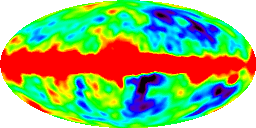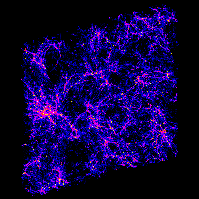Hugh Couchman
Professor
Department of Physics and Astronomy
McMaster University
 I am interested in how cosmic structure develops from tiny ripples in
the density of the universe at early times to the rich variety of
structure that we see at present: galaxies, cluster of galaxies and
the giant sheets, filaments and voids of large-scale structure.
I am interested in how cosmic structure develops from tiny ripples in
the density of the universe at early times to the rich variety of
structure that we see at present: galaxies, cluster of galaxies and
the giant sheets, filaments and voids of large-scale structure.
After about one hundred thousand (105) years of expansion
following the Big Bang, the hot, ionized gas, or plasma, filling the
universe had cooled sufficiently that it recombined. This
recombination event is observable as a sea of microwaves pervading the
universe. This background radiation shows us that the matter in the
iniverse was almost completely smooth at that time. Yet, when we look
at the nearby universe, some 10 billion (1010) years later,
it is full of huge contrasts: very dense objects, galaxies, stars and
planets, embedded in a universe with an average density far smaller
that the best terrestrial vacuum.
 Gravity plays a central role in growing today's structures from those
small initial density fluctuations. We can follow how the ripples grow
analytically until they become non-linear (analogous to a wave
beginning to break), but beyond that, although the governing equations
are basically Newtonian, the complex behaviour of the cosmic density
field can only be modelled numerically.
Gravity plays a central role in growing today's structures from those
small initial density fluctuations. We can follow how the ripples grow
analytically until they become non-linear (analogous to a wave
beginning to break), but beyond that, although the governing equations
are basically Newtonian, the complex behaviour of the cosmic density
field can only be modelled numerically.
Simulating the growth of cosmic structure, from the star clusters and
gas within galaxies to the large superclusters containing tens of
thousands of galaxies and beyond, is a huge computational challenge
(indeed, it is has been called on of the "Grand Computational
Challenges" along with global environmental modelling and protein
folding for example) because of the vast range of mass (at least
109) and timescale (at least 105) involved. My
research uses computers from desktops to massively parallel
supercomputers to follow the forces that shape the the structure that
we observe in the universe.
Image Credits: NASA, Rob Thacker
 Gravity plays a central role in growing today's structures from those
small initial density fluctuations. We can follow how the ripples grow
analytically until they become non-linear (analogous to a wave
beginning to break), but beyond that, although the governing equations
are basically Newtonian, the complex behaviour of the cosmic density
field can only be modelled numerically.
Gravity plays a central role in growing today's structures from those
small initial density fluctuations. We can follow how the ripples grow
analytically until they become non-linear (analogous to a wave
beginning to break), but beyond that, although the governing equations
are basically Newtonian, the complex behaviour of the cosmic density
field can only be modelled numerically.
 I am interested in how cosmic structure develops from tiny ripples in
the density of the universe at early times to the rich variety of
structure that we see at present: galaxies, cluster of galaxies and
the giant sheets, filaments and voids of large-scale structure.
I am interested in how cosmic structure develops from tiny ripples in
the density of the universe at early times to the rich variety of
structure that we see at present: galaxies, cluster of galaxies and
the giant sheets, filaments and voids of large-scale structure.